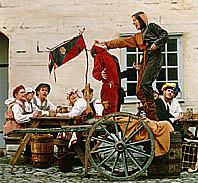Meet the Middle Ages
BackMusic and dancing

There was music, singing and dancing in many different places in town. In the churches and the monasteries one heard Gregorian chants, a rather monotonous kind of singing with many variations. When celebrating the saints and at big feasts, people were dancing at church. The singing and dancing could be accompanied by flutes, drums, cymbals or, in the late Middle Ages, church-organs.
At fairs or feasts, wandering minstrels performed at the market-places. They played and sang their songs and tunes, entertaining people and telling the latest news. The minstrels were sometimes called pipers, jesters or troubadours.
The minstrels often sang ballads. The songs were about love, knights, historical events, supernatural beings or saints. One of the most famous ballads was the song about Ebbe Skammelsson, others are the legend songs about Staffan the Stableboy. Ridom, ridom (Ride, ride), a dancing melody from Iceland, is another example; it is a song about nature and supernatural beings.
Many medieval songs were satirical and made for fun. At the feasts in May, the young women sang about the many faults of the men. These songs were often about dice playing, fights at the tavern or drunkenness. In return, the young men sang about how lazy, deceitful, quarrelsome and gossiping the women were. The songs were sometimes indecent. Parents often tried to stop their children from learning these songs.
Many instruments were used when singing and dancing: the flute, the drum, the fiddle, the lute or the bagpipe.
If you would like to know more about how people danced in the Middle Ages, read "Country Life. Music and Dancing"